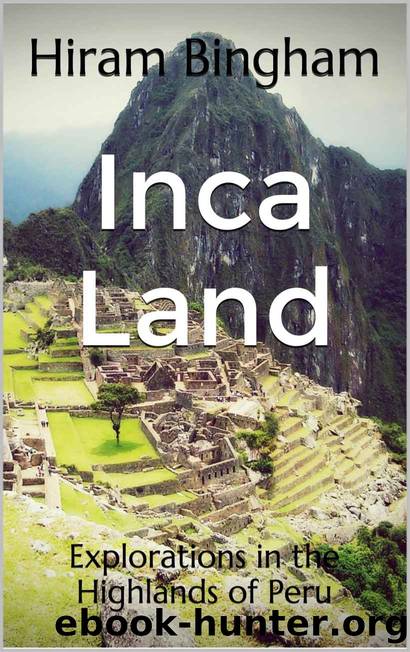Inca Land: Explorations in the Highlands of Peru (Illustrated) by Hiram Bingham

Author:Hiram Bingham [Bingham, Hiram]
Language: eng
Format: epub
Published: 2014-05-08T00:00:00+00:00
The Urubamba Canyon
A reason for the safety of the Incas in Uilcapampa.
The fugitives returned to Cuzco and reported their misfortune. The importance of the reverse will be better appreciated if one remembers that the size of the force with which Pizarro conquered Peru was less than two hundred, only a few times larger than Captain Villadiego's company which had been wiped out by Manco. Its significance is further increased by the fact that the contemporary Spanish writers, with all their tendency to exaggerate, placed Manco's force at only “a little more than eighty Indians.” Probably there were not even that many. The wonder is that the Inca's army was not reported as being several thousand.
Francisco Pizarro himself now hastily set out with a body of soldiers determined to punish this young Inca who had inflicted such a blow on the prestige of Spanish arms, “but this attempt also failed,” for the Inca had withdrawn across the rivers and mountains of Uilcapampa to Uiticos, where, according to Cieza de Leon, he cheered his followers with the sight of the heads of his enemies. Unfortunately for accuracy, the custom of displaying on the ends of pikes the heads of one's enemies was European and not Peruvian. To be sure, the savage Indians of some of the Amazonian jungles do sometimes decapitate their enemies, remove the bones of the skull, dry the shrunken scalp and face, and wear the trophy as a mark of prowess just as the North American Indians did the scalps of their enemies. Such customs had no place among the peace-loving Inca agriculturists of central Peru. There were no Spaniards living with Manco at that time to report any such outrage on the bodies of Captain Villadiego's unfortunate men. Probably the conquistadores supposed that Manco did what the Spaniards would have done under similar circumstances.
Following the failure of Francisco Pizarro to penetrate to Uiticos, his brother, Gonzalo, “undertook the pursuit of the Inca and occupied some of his passes and bridges,” but was unsuccessful in penetrating the mountain labyrinth. Being less foolhardy than Captain Villadiego, he did not come into actual conflict with Manco. Unable to subdue the young Inca or prevent his raids on travelers from Cuzco to Lima, Francisco Pizarro, “with the assent of the royal officers who were with him,” established the city of Ayacucho at a convenient point on the road, so as to make it secure for travelers. Nevertheless, according to Montesinos, Manco caused the good people of Ayacucho quite a little trouble. Finally, Francisco Pizarro, “having taken one of Manco's wives prisoner with other Indians, stripped and flogged her, and then shot her to death with arrows.”
Accounts of what happened in Uiticos under the rule of Manco are not very satisfactory. Father Calancha, who published in 1639 his “Coronica Moralizada,” or “pious account of the missionary activities of the Augustinians” in Peru, says that the Inca Manco was obeyed by all the Indians who lived in a region extending “for two hundred leagues
Download
This site does not store any files on its server. We only index and link to content provided by other sites. Please contact the content providers to delete copyright contents if any and email us, we'll remove relevant links or contents immediately.
The Daily Stoic by Holiday Ryan & Hanselman Stephen(2703)
The Fate of Rome: Climate, Disease, and the End of an Empire (The Princeton History of the Ancient World) by Kyle Harper(2431)
People of the Earth: An Introduction to World Prehistory by Dr. Brian Fagan & Nadia Durrani(2345)
Ancient Worlds by Michael Scott(2098)
Babylon's Ark by Lawrence Anthony(2066)
Foreign Devils on the Silk Road: The Search for the Lost Treasures of Central Asia by Peter Hopkirk(2053)
India's Ancient Past by R.S. Sharma(1982)
MOSES THE EGYPTIAN by Jan Assmann(1968)
The Complete Dead Sea Scrolls in English (7th Edition) (Penguin Classics) by Geza Vermes(1837)
Lost Technologies of Ancient Egypt by Christopher Dunn(1796)
The Daily Stoic by Ryan Holiday & Stephen Hanselman(1764)
The Earth Chronicles Handbook by Zecharia Sitchin(1742)
24 Hours in Ancient Rome by Philip Matyszak(1675)
Alexander the Great by Philip Freeman(1642)
Aztec by Gary Jennings(1541)
The Nine Waves of Creation by Carl Johan Calleman(1518)
Curse Tablets and Binding Spells from the Ancient World by Gager John G.;(1509)
Before Atlantis by Frank Joseph(1481)
Earthmare: The Lost Book of Wars by Cergat(1465)
